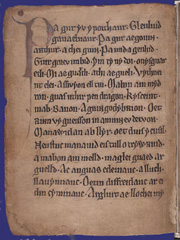Pa gur facts for kids

Pa gur yv y porthaur? (meaning "What man is the gatekeeper?") is an old poem from the Black Book of Carmarthen. People often call it Pa gur for short. It's also known as Ymddiddan Arthur a Glewlwyd Gafaelfawr ("The talk between Arthur and Glewlwyd Gafaelfawr").
This poem is written in Old Welsh and is like a conversation. It's between the famous King Arthur and a gatekeeper named Glewlwyd Gafaelfawr. In the poem, Arthur brags about his own adventures and the brave deeds of his friends, especially Cai the Fair.
Pa gur is important because it's one of the earliest stories about King Arthur written in a common language, not Latin. It also mentions many of Arthur's early adventures that we don't have full stories for anymore. Experts think the poem was written around the year 1100.
Contents
What the Poem is About
The poem starts with Arthur asking the gatekeeper his name. The gatekeeper, Glewlwyd Gafaelfawr, tells Arthur his name and asks Arthur for his. Arthur then says who he is and that he is with Cai the Fair and "the best men in the world."
Glewlwyd asks Arthur to prove who his men are. So, Arthur names his companions and talks about their brave actions. Some of them are:
- Mabon son of Modron, who served Uther Pendragon.
- Manawydan son of Llŷr, who carried "pierced shields from Tryfrwyd."
- Anwas the Winged and Llwch the Windy-Handed, who defended Edinburgh.
- Cai, who was so strong he could kill three enemies at once.
The poem then talks about Arthur's own fights. He fought a witch in Afarnach's hall and dog-headed creatures at Edinburgh. Bedwyr Perfect-Sinew was also a great fighter, killing many enemies.
Arthur praises Cai's fighting skills a lot. He even says:
I had servants,
it was better when they were alive.
Arthur remembers seeing Cai rush into battle. Cai was very strong and brave.
When he drank from a horn
he would drink like four.
The poem suggests that only God could defeat Cai. Cai and another warrior, Llachau, were known for winning battles. Cai fought nine witches and lions in Anglesey. The poem then starts to describe a terrible cat named Cath Palug, against whom Cai's shield was "polished."
Nine-score soldiers
would fall as its food;
nine-score champions…
The rest of the poem is missing, so we don't know how it ends.
When and Where the Poem Was Made
It's hard to figure out the exact age of very old Welsh texts. Pa gur is a good example of this challenge.
In the past, some experts thought it was from the 10th or 11th century. Others even thought it could be as old as the 8th or 9th century. However, most experts now agree that the poem was likely written around the year 1100.
Less is known about where Pa gur was written. But some experts think it might have been created in south-east Wales. This idea comes from how the poem is similar to other old Welsh writings from that area.
King Arthur in the Poem
In Pa gur, King Arthur is shown as a hero who wanders around. He leads a group of other heroes on many adventures. They fight monsters and magical enemies. This is similar to the fíanna stories from old Irish literature.
Arthur's friends, like Cai and Bedwyr, are important characters in later Arthurian legends. Each of them has special skills they use in battles. Arthur himself is a strong fighter, not just a leader.
Some people think Arthur might have had magical powers in the poem, like being able to make himself and his men invisible. But this idea comes from a part of the poem that is hard to translate. The poem generally feels light-hearted and fun. However, Arthur often talks about his friends' past achievements, which might suggest he's looking back at a time when he was more glorious.
How the Poem Connects to Other Stories
Pa gur is often compared to the story of Culhwch and Olwen. Both stories mention many adventures of Arthur and his men. In Pa gur, the gatekeeper Glewlwyd Gafaelfawr questions Arthur before letting him in. In Culhwch and Olwen, Glewlwyd, who is Arthur's gatekeeper, also questions Culhwch. Later, another gatekeeper questions Cai.
Experts aren't sure how these parts are related. Maybe the writer of Culhwch was making fun of Pa gur. Or maybe both writers were using the same old Arthurian traditions. Similar scenes with gatekeepers appear in other old stories too.
The cat of Palug, which Cai fought, also appears in other Welsh stories. Wild cats appear in later French Arthurian stories. In one English story, Arthur defeats wildcats by tricking them into attacking their own reflections in his glass shield. This might explain why Cai's shield was "polished" when he fought the cat in Pa gur.
The fight at Tryfrwyd in Pa gur seems to be the same as the "bellum Tribruit" battle. This battle is listed as one of Arthur's twelve battles in another old text called Historia Brittonum. But in Pa gur, this battle is mythical. It's fought against a werewolf and an army of dog-headed monsters.
The nine witches mentioned in Pa gur are similar to witches in other old Welsh and Breton stories. For example, there are nine witches in Peredur and nine maidens in Preiddeu Annwn.
Some characters' names in Pa gur, like Manawydan son of Llyr and Mabon son of Modron, come from Welsh mythology. These myths were also used in the Four Branches of the Mabinogi.
The "lords of Emrys" mentioned in the poem might refer to a historical figure named Ambrosius. However, the word "Emrys" was also used by Welsh poets to mean Gwynedd.
Modern Translations
Many people have translated Pa gur into modern languages so more people can read it.

